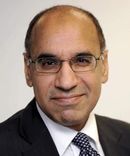Keynote Speakers
Implantable and Ingestible Sensing Enabled by Circuit and System Innovations
With more people living longer and chronic diseases on the rise, traditional healthcare
systems are pushed to their limits. Costs skyrocket, specialized personnel is hard to find, and
emerging treatments and tools are not universally available. A future in which smart health
concepts such as precision medicine and genomics are brought within everyone's reach is
needed as this will result in personalized treatments with better outcomes and lower costs.
Furthermore, managing health should be an integral part of the future of healthcare: a focus
on prediction, prevention or interception of disease next to the focus on disease
management.
To make such future possible, disruptive hardware and AI innovations are needed.
On the hardware side, new yet volume-scalable sensing technologies are needed as well as
edge AI hardware for signal processing and closed-loop control. Personalized digital twin
models need to be created based on these new sources of data to help both individuals and
their doctors and pharma and medtech industry.
This presentation will give an overview of sensor, circuit, system, data analytics and
application innovation conducted at imec in OnePlanet and imec at Holst Centre. Ingestible
sensor innovations and implantable device innovations will be presented.50 Years Real-Time Electronic Sector Scanning
In the early sixties, many pioneers investigated the possibilities of ultrasound pulse-echo techniques for diagnostic purposes. The main areas were neurology, gynaecology & obstetrics, radiology and ophtalmology. The Institute of Medical Physics where I was employed had close connections with some neurologists pioneering in ultrasound for brain diagnostics. The experts often were relatively successful as far as it concerned A-scan. In contrast to this, attempts to obtain useful results with B-scan were very disappointing. I was convinced that the relative success of A-scan, in spite of its one-dimensional character, was due to the fact that A-scan is a true real-time system. That makes searching for the best picture possible by moving the probe slightly while observing the result simultaneously.
The trials with all kinds of mechanical B-scan systems, in order to obtain two-dimensional pictures, suffered from the fact that one sees the result only after the scan is completed. The results were extremely disappointing for brain imaging, mainly due to irregularly shaped skull bone and its high absorption. I was absolutely convinced that two-dimensional scanning at a high repetition rate and with an essentially stationary probe would provide superior results. Observing moving objects, like the heart, would probably become possible. Both for brain and heart a probe with a small “footprint” is essential, as was the case already with A-scan equipment. In 1964 we decided to explore if such a new system is feasible. We would then have a fast B-scan system comparable with A-scan but with the vital difference that it is two-dimensional and real-time. We started to develop such a system of which the first prototype, the Electroscan, became operational in the beginning of 1969. It was able to produce real time ultrasound images in the form of a sector of 90 degrees, divided in 32 different directions, and with a scanning rate of 30 frames per second. This system was published at the 1st World Congress of the WFUMB in Vienna, 1969. This obviously explains the title of this lecture. We can say now that the success of electronic sector scanning has been enormous. It is applied in numerous medical areas. In echo-cardiography, for instance, the use of “phased array” has become almost exclusive. The Electroscan was developed in a period in which the computer and chip technology were relatively at a poor level.
The fact that nowadays even 3-dimensional real-time scanners exist shows clearly how much ‘good ideas’ are dependant on technical developments.
Ubiquitous Diagnostics for Biophysical and Biochemical Biomarkers for Healthcare
There is a need for more personalised quantitative information that can provide actionable feedback for the prevention, early diagnosis or management of disease. There has been an increasing trend in the development of wearable and point-of-care (PoC) diagnostics that can provide remote and (quasi)continuous quantification of biophysical and biochemical biomarkers. To realise this vision, these devices need to be ubiquitous and reliable. We have previously described volume manufacturing approaches for low-cost electrochemical sensing of biochemical biomarkers. An increase in the number of devices can, however, lead to the generation of electronic waste and so there is requirement that these are underpinned by circularity. In this talk, we will discuss the design choice for ubiquitous diagnostics in sensing modalities, power, connectivity, data analytics, volume manufacturing as well applications and the requirements for sustainability.




